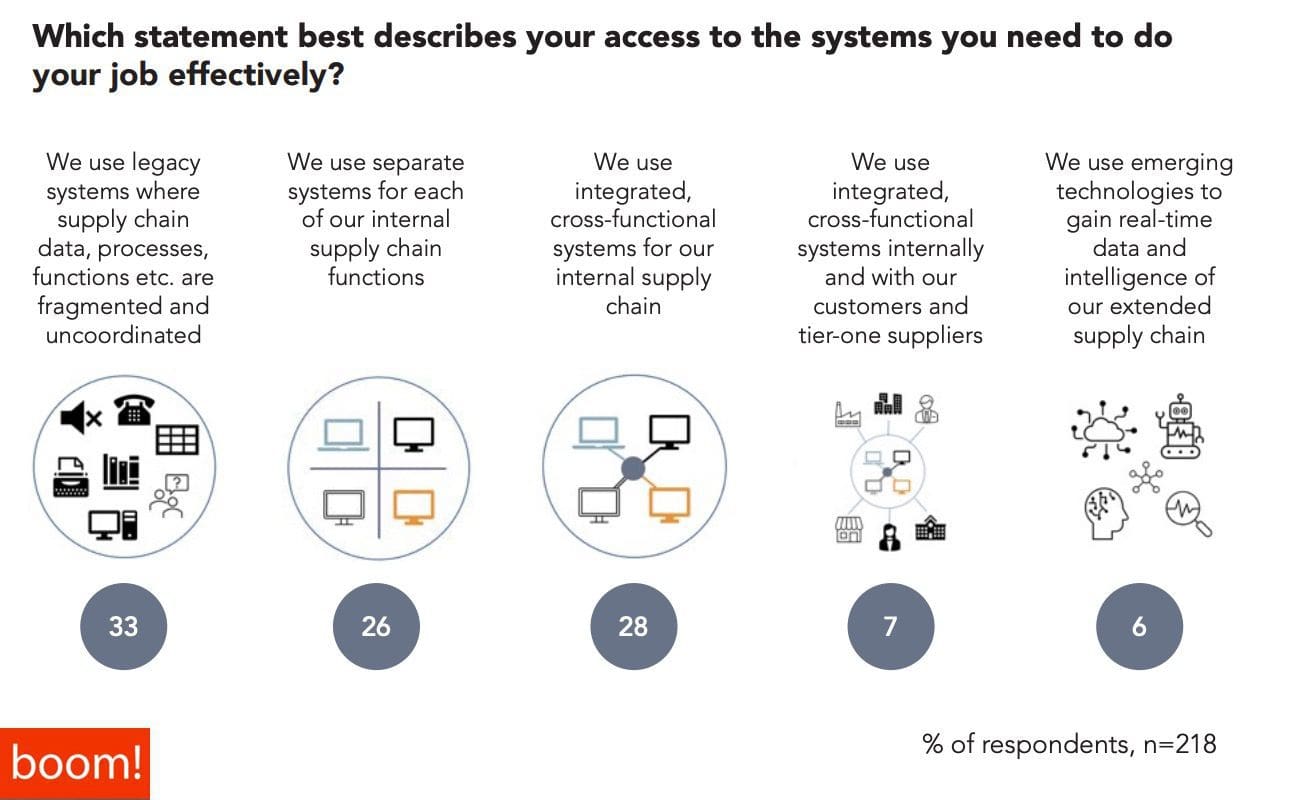

What almost cost $2B a day and more than 700,000 jobs in the US alone, but would have led to global reverberations? The rail industry was on the brink of a strike-induced labor shortage that would have happened overnight if the President hadn’t intervened. This averted disruption is just one recent example of the impact of a labor shortage on supply chain planning and execution. If a strike is a flood – a sudden event that can occur suddenly with catastrophic effects – the loss of supply chain talent is a slow leak. LinkedIn reported earlier this year that supply chain turnover was up 28%. A talent leak may appear less dramatic than a strike but can have equally pernicious effects. In the 2022 MHI Annual Industry Report, 54% of respondents cited hiring and retaining qualified workers as a threat second only to disruptions. Preventing talent leak entails paying attention to what supply chain managers need to succeed.
The Boom Global Network recently conducted a survey, “What the Thriving Supply Chain Professional Needs to Succeed,” and found that they want support for their ambition; the right tools; and leadership with vision, clarity, and compassion. Artificial intelligence and technology can address these issues, but maybe not in the way you think. Talk of a “lights out” supply chain suggests we can replace missing workers with machines. But instead we should look to AI/ML to boost the productivity of our existing talent by augmenting their capabilities, allowing us to retain them and grow their impact rather than replace them.

Help me grow in my career
Supply chain professionals love challenge, teamwork, and the impact they have on the core of their business. But in the boom! survey, 28% reported plans to change jobs in the coming year (echoing the LinkedIn data referenced above), a higher rate than before the pandemic. The top two reasons for leaving were inability to achieve career goals fast enough (31%) and desire to better use their skills and current abilities (20%), factors that grow even stronger as they advance in their careers, trumping the search for better pay and benefits. What happens if that ambition is not fulfilled? You lose your most mature talent, with the greatest knowledge and institutional memory.
How can you get supply chain talent to stay? By investing in their professional development, the second highest priority boom! survey respondents ranked. Advanced analytics (35%), digital transformation (33%) and artificial intelligence and machine learning (AI/ML, 32%) were three of the top four areas listed as topics of interest for professional development. How can AI/ML help these professionals advance in their career and do more with what they know?
Rather than turn the lights out, we should opt to augment humans, not replace them. Machine intelligence can complement human intelligence to accelerate intuition. For example, keeping supply lead times up to date in a planning system is harder than ever, and the more complicated the bill of materials the less likely a planner is able to do more than spread outdated assumptions across parts. Not every adjustment is worth a planner’s time to update, but AI/ML can predict lead times, based on historical patterns, and update changes automatically, flagging for intervention only those changes outside parameters the planner sets herself. A “self-healing supply chain” allows her to use her current skills and abilities better, by focusing her time on more complex exceptions instead of tedious manual updates, and learn new skills as she understands how to “consume” results from AI/ML to make better decisions.
Invest in better tools to address the labor shortage
When supply chain professionals were offered a magic wand in the boom! survey, what was their #1 wish for to boost their work performance? Better, integrated tools, and no wonder. When asked to describe their world, 59% said they use legacy systems that are fragmented, uncoordinated, and siloed. In spite of their well-known limitations, a survey by consulting firm McKinsey that found that spreadsheets remain the top software for supply chain planning, in use by 73%. Ongoing use of spreadsheets can even put your supply chain at risk.
The supply chain labor shortage is driving investment in digital transformation, which MHI argues will create provide paths to give employees new skills and attract talent who want to work on modern systems. Modernizing the environment for her team, in addition to poor forecasts and inventory levels, sent Lizet Tymon in search of better options than the homegrown tools and spreadsheets they were using. The transition to concurrent planning and her leadership enabled a very profitable planning-as-a-service option for her company, Jabil. Lizet’s story illustrates the importance of leadership, in combination with technology, to reap the benefits of the investment.
Lead with vision, clarity and compassion
In fact, more than half of the boom! respondents ranked “visible, empowering senior leadership with a clear, well-communicated strategic vision” as the most important resource needed to help them in their role. Another 35% wished for leaders like Lizet, who are willing to support and implement change. Because moving from spreadsheets to digitally integrated tools entails a digital transformation, which won’t happen on its own. In spite of our wishes, there are no magic wands in supply chain.
Giving supply chain managers better, integrated tools will break them out of spreadsheet prison and make it easier to collaborate, working together in teams to make the impact they desire. Removing tedium from their tasks with AI/ML can free them to use more of their current skills and learn new ones. But fear can get in the way for those who worry that AI/ML will automate them out of a job.
TRUST Resistance to change and the unknown leads to suboptimal results. As two leading operations professors observed in the Woolsey-Swanson rule that bears their names: “People would rather live with a problem they cannot solve than accept a solution they cannot understand.” One way to facilitate acceptance of the solution is to build trust by incorporating interpretability into AI/ML solutions, which are prized for their greater predictive accuracy but delivered in a black box. Demand for AI/ML has driven options for interpretability, a term for a variety of techniques that can increase understanding of the factors in producing the predictions.
Conclusion
While discussions of an autonomous supply chain can feed fear, turn the discussion around by emphasizing that AI/ML works best when it complements human intelligence. AI/ML models literally learn from data, but when data is disrupted by black swan events the learning is interrupted. In these times we must rely on human intelligence to make decisions, just as we did early in the pandemic.
Supply chain professionals want to use their current skills more and learn new ones. They want access to a single version of the truth working in a digitally integrated world so they can plan concurrently. They want leadership with vision willing to make change. Digital transformations that include AI/ML can empower and motivate planners on all these dimensions. Supply chains are only as good as the humans who run them, rendering a supply chain labor shortage a significant risk. People are our most valuable asset. Listen to what your supply chain professionals want and invest in the technology to give them what they need.
 Polly Mitchell-Guthrie is the VP of Industry Outreach and Thought Leadership at Kinaxis, the leader in empowering people to make confident supply chain decisions. Previously she served in roles as director of Analytical Consulting Services at the University of North Carolina Health Care System, senior manager of the Advanced Analytics Customer Liaison Group in SAS’ Research and Development Division, and Director of the SAS Global Academic Program.
Polly Mitchell-Guthrie is the VP of Industry Outreach and Thought Leadership at Kinaxis, the leader in empowering people to make confident supply chain decisions. Previously she served in roles as director of Analytical Consulting Services at the University of North Carolina Health Care System, senior manager of the Advanced Analytics Customer Liaison Group in SAS’ Research and Development Division, and Director of the SAS Global Academic Program.
Mitchell-Guthrie has an MBA from the Kenan-Flagler Business School of the University of North Carolina at Chapel Hill, where she also received her BA in political science as a Morehead Scholar. She has been active in many roles within INFORMS (the Institute for Operations Research and Management Sciences), including serving as the chair and vice chair of the Analytics Certification Board and secretary of the Analytics Society.
The post How AI/ML can address the supply chain labor shortage…but not like you think! appeared first on Logistics Viewpoints.
